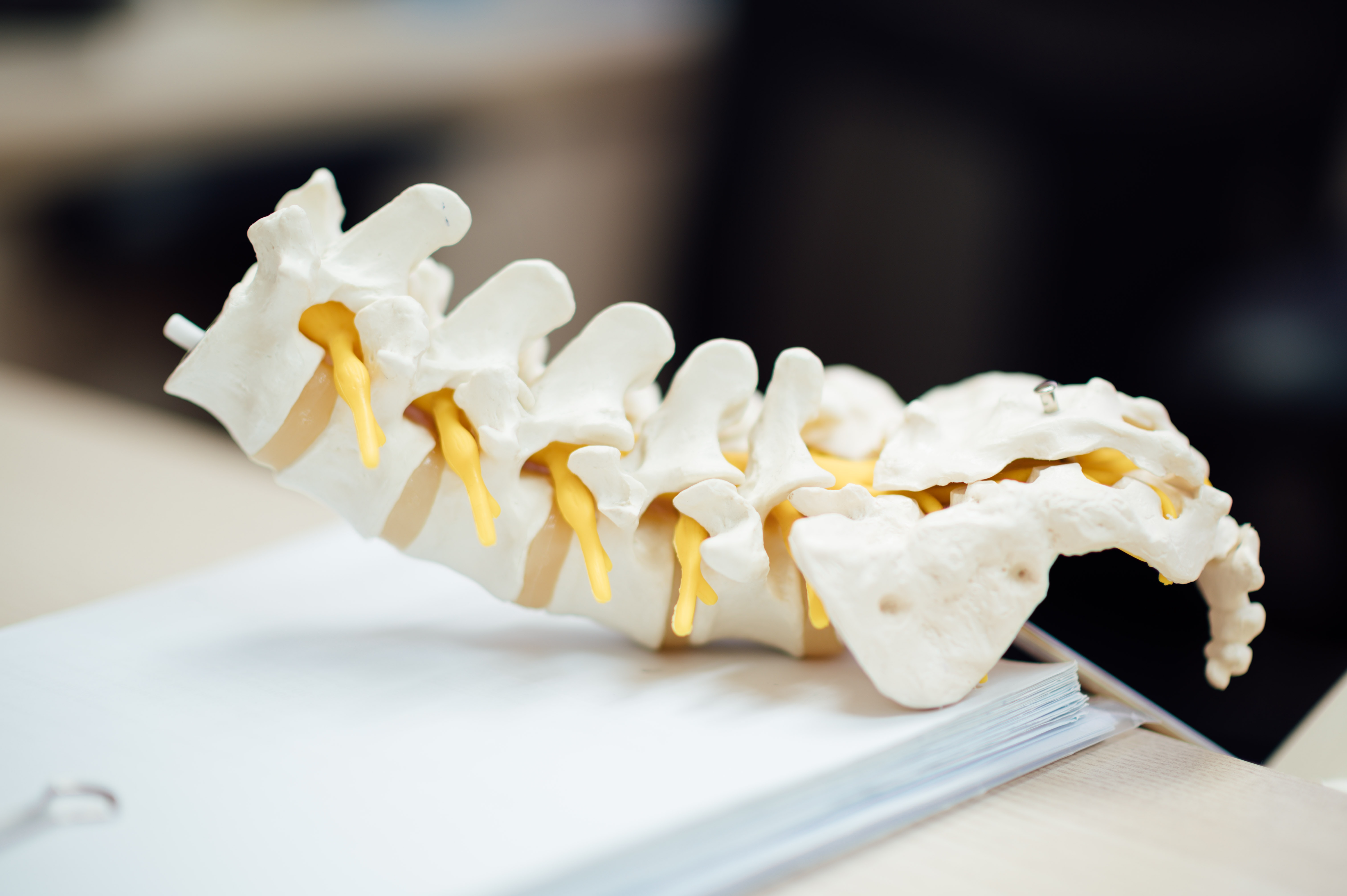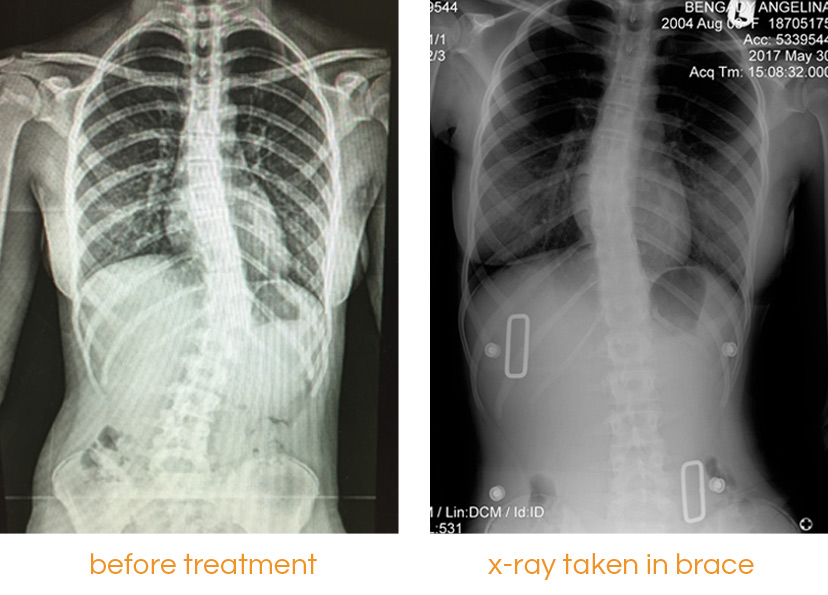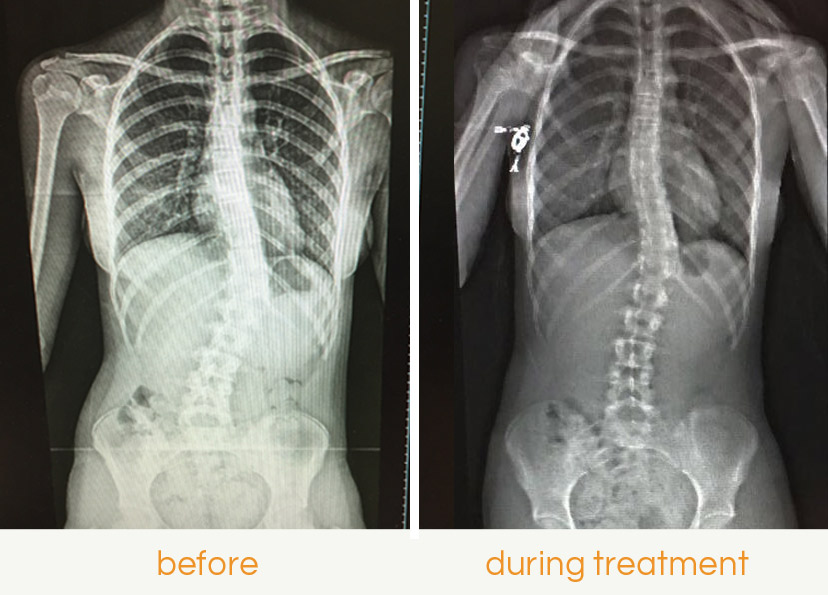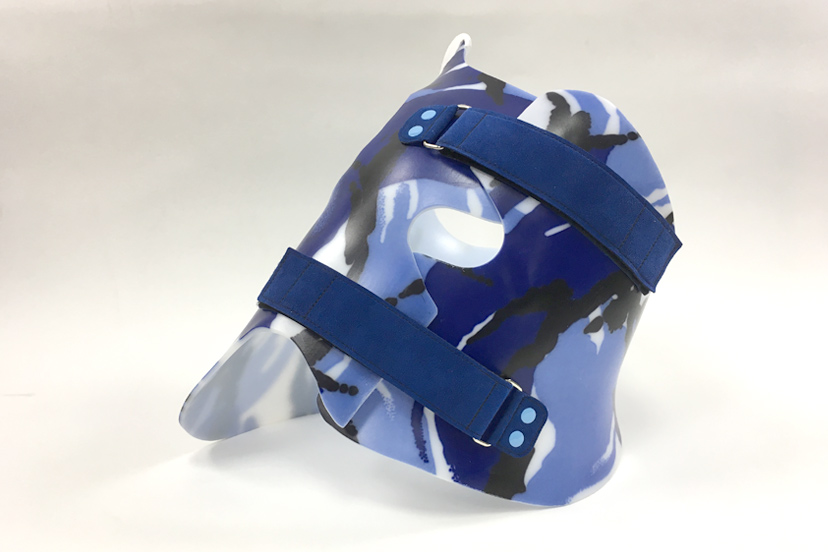
17 January 2018
Motivated Angelina is a thirteen-year-old scoliosis patient currently going through Cheneau-Gensingen Brace treatment, here her mother Paola talks to us about her scoliosis journey and her experience with the brace.
Paola recalls when it all started, “Angelina was walking funny, so I took her to a chiropractor because I could see through her uniform that she was leaning to one side, so I took her to the chiropractor. They then told me to make an emergency appointment with the doctor. The doctor said there was something wrong with her back, and they sent her to a consultant who took X-Rays, an MRI scan and eventually came back and said that Angelina had scoliosis and a 40° curve.”
After being passed from pillar to post, Paola wanted answers. “I asked what can we do? He responded with ‘nothing for now, just let her be and we will assess the situation again in six months. She was twelve at the time.”
“I spent two to three days attached to the computer trying to find out what the best treatment was, and where it was. At one point it was pointing to America, then Italy. I had heard of Katharina Schroth so I knew the treatment was made by someone who had scoliosis, so it had to work.”
Paola says she “read a lot and at one point I was considering taking Angelina to Germany, but then I came across LOC. It was late in the evening, (LOC) said that they were setting up a clinic for girls with scoliosis and invited Angelina and I to come along when it opened. I needed to act quickly. When I went along, they assessed Angelina and said she can do it but she would need to have a brace as well.”

“the brace is very light. Obviously, the first couple of days we were told it was going to be uncomfortable for her, I bought so many pillows! But although the first night was not very comfortable, the second night she got used to it and then she was wearing it all day long and I thought ‘that’s brilliant!’ She was only taking it off for two or three hours to go out with friends or do the exercises, but she didn’t have any problems really.”
“If I had any problems, like once when Angelina told me that it was hurting a bit underneath her breast as she was growing, I went back and Sally put it right. They work with you which is good.”
“I can phone them anytime I’ve got a problem and they are always there. I mean I didn’t have many issues but I know I can always phone her or Whatsapp her. When I got the report from the consultant I sent it to Sally’s Whatsapp during the week and even the consultant was surprised because he wasn’t expecting those kind of results.”
“It was 40° and after six weeks went down to 31. Yeah so I’m pleased, I mean, if she can get down to 11° or 12° she can live with that. I’m hoping to get down so low that even if she’s still got scoliosis, she won’t suffer from it and she won’t require an operation. These kids [with scoliosis] if they’re flexible, it can normally be corrected. Once they stop growing, it hardens so it won’t go back to what it was before.”
"LOC teaches them, they don't let them only do Schroth physiotherapy exercises, they teach them. Everyone has a personalised exercise plan so they can do it at home because they need to do them for about 40 minutes a day. LOC teaches them how the body and spine work, how they should be sitting down during the day, and when they need to put their legs in a certain manner so that their spine can keep a certain position. These are all practical things. My daughter goes to school and when she sits, she doesn’t sit like other kids, she sits with her legs in a specific position because she knows that her spine is straight, and that’s the position she needs to keep.”
“The Schroth treatment and the brace – they work. I want other people to know so that they can have that option, instead of surgery.”

"LOC are fantastic. I mean, they’ve become like family now. They are extraordinary people and do such good work with these kids, both of them, it’s fantastic. The whole experience has been very good. They make you feel welcome from the beginning, and you can ask as many questions as you want, and they answer everything. If you have a problem they give you their personal mobile so you can just call them if you have a problem and they’ll solve it straight away. I’m very pleased with the treatment, the people, with everything."
It should be advertised more because it really, really saves the lives of these kids. How dreadful to have to go through the ordeal of a spinal surgery operation, how dreadful? I tell everybody this if they tell me they’ve got scoliosis, I keep LOC’s number on my phone and say ‘try this, before you do anything, just try this because it does work’ I show them the picture of my daughter and her X-rays because I don’t want people to go for the operation unless it’s the last resort.”
“She’s wearing the brace all the time now and she’s doing very well. She’s very good at school too, the brace doesn’t get in the way of anything. It fits underneath her school uniform and you can’t see it. Sometimes I even have to ask her when she’s sitting down if she’s wearing it because I can’t see it! She says ‘of course mummy’ and I say ‘let me try!’ I have to knock through the clothes and only then can I hear she’s wearing the brace!”
A series of studies using the Cheneau-Gensingen Brace have produced success rates of over 85%. The brace has also been used successfully to address Cobb angles in excess of 40° where surgery would previously have been advised. Get in touch today if you would like to know more, or book an appointment at our scoliosis clinic.

The operation used to treat severe scoliosis curves is typically spinal fusion surgery; a major procedure that involves moving muscles and realigning the skeleton into place. The curved, deformed vertebrae are fused together into a single bone, putting metal screws and rods into the spine to help straighten it. Surgery typically lasts between 4 and 8 hours depending on the severity of the curve. Bone graft is then taken from other parts of the body and used to cover the implants.
Following the operation, it is necessary to spend around a week in intensive care before returning home and the first few days are often uncomfortable. Most adolescents can expect to return to school from 2-4 weeks following surgery, but pain medication may be required up to 6 weeks following. A full recovery from the procedure can take up to a year, as it can take that long for the spine to heal fully.
Spinal fusion surgery causes the fused portion of the back to become permanently stiff, as a result, returning to sports that require large amounts of flexibility (ballet, yoga, gymnastics, dance) or contact (rugby, football, karate, hockey) may take longer.
Risks of spinal fusion surgery are like that of any other major procedure and include infection, blood clots and anaesthesia complications. The added risks include permanent nerve damage to the spine and paralysis.